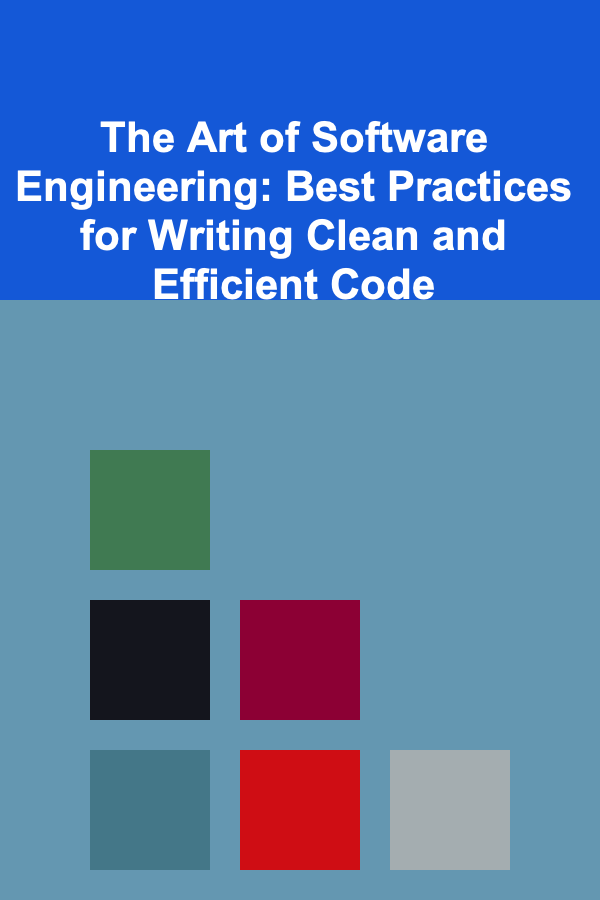
The Art of Software Engineering: Best Practices for Writing Clean and Efficient Code
ebook include PDF & Audio bundle (Micro Guide)
$12.99$10.99
Limited Time Offer! Order within the next:

Software engineering is an intricate craft that blends problem-solving, design thinking, and deep technical knowledge. One of the core pillars of effective software engineering is writing clean, efficient code. Clean code is easier to maintain, debug, and extend, while efficient code ensures the program performs optimally in real-world conditions. In this guide, we'll explore the best practices and strategies for writing both clean and efficient code, drawing upon the expertise of experienced developers to highlight the methods that ensure high-quality software.
What Is Clean Code?
Clean code refers to code that is easy to read, understand, and maintain. It follows consistent conventions, avoids unnecessary complexity, and minimizes errors. Clean code isn't just about making code syntactically correct; it's about making it easy for anyone (including future developers) to understand what the code is doing and why it is doing it.
Characteristics of Clean Code
- Readability: Code should be easily readable by humans. It should make logical sense and not require excessive mental effort to understand.
- Simplicity: Clean code avoids unnecessary complexity. It solves problems in the simplest way possible while remaining effective.
- Consistency: Code should follow consistent naming conventions, structures, and patterns to make it easy to follow.
- Minimalism: Clean code avoids unnecessary lines, functions, or components that don't add value.
- Scalability: The code is designed with future changes in mind, ensuring that it can scale or be modified with minimal disruption.
What Is Efficient Code?
Efficient code is code that performs its intended task as quickly and with as little resource usage as possible. Efficiency in software engineering refers to both the performance of the code (how fast it runs) and the resources it consumes (such as memory, CPU, and bandwidth). While clean code focuses on maintainability and readability, efficient code ensures that the system performs optimally under real-world conditions.
Characteristics of Efficient Code
- Low Latency: The code runs quickly and responds to user inputs without noticeable delays.
- Optimal Memory Usage: Efficient code minimizes memory usage, avoiding unnecessary memory allocations and leaks.
- Scalable: It can handle increasing loads without significant performance degradation.
- Resource Management: It effectively manages computational resources, such as network bandwidth and disk space, especially in distributed systems.
Best Practices for Writing Clean and Efficient Code
1. Follow the Single Responsibility Principle (SRP)
One of the core principles of writing clean code is the Single Responsibility Principle (SRP), a concept from the SOLID design principles. This principle states that each module or function in your code should have only one responsibility and should do one thing well.
- Why it's clean: A function with a single responsibility is easier to understand, test, and maintain. It is clear what the function is doing, and there is less chance for unintended side effects.
- Why it's efficient: Having smaller, more focused functions often results in less complexity, making the code more efficient in terms of both execution and resource consumption.
Example : Instead of a large processOrder function that handles order validation, payment processing, and order shipping, break it down into smaller, dedicated functions like validateOrder, processPayment, and shipOrder.
2. Keep Functions Small and Focused
In addition to SRP, always keep your functions as small and focused as possible. Ideally, a function should perform a single task and do so in a concise manner.
- Why it's clean: Small functions are easier to read and test. When a function performs only one task, it is clear and intuitive.
- Why it's efficient: Small functions are easier to optimize and have a lower cognitive load. The performance benefits come from minimizing the number of operations a function performs, allowing you to pinpoint potential bottlenecks more easily.
Example: A function that sorts a list of orders should only sort the list and return the result, rather than also printing debug messages or performing other unrelated tasks.
3. Use Meaningful Names for Variables, Functions, and Classes
One of the most significant aspects of writing clean code is choosing descriptive names. Variables, functions, and classes should be named to describe their purpose and behavior.
- Why it's clean: Meaningful names make code self-documenting. Developers can understand the purpose of a variable or function without needing to dive into the implementation.
- Why it's efficient: When code is self-explanatory, developers spend less time interpreting it, reducing the risk of mistakes and inefficiencies in future updates.
Example : Instead of naming a function foo() or a variable x, name them something descriptive, like calculateShippingCost() or orderTotalAmount.
4. Avoid Duplication: DRY (Don't Repeat Yourself)
Duplication is the enemy of both clean and efficient code. When you repeat code, it increases maintenance overhead and makes the code more prone to bugs. This is where the DRY principle comes in: Don't Repeat Yourself.
- Why it's clean: Repeating code makes it harder to maintain and understand. If a bug appears in one location, it's easy to forget to fix it in others.
- Why it's efficient: Duplicate code increases the size of your codebase unnecessarily, leading to more memory usage and slower performance in the long run.
Example: If you find yourself writing similar validation logic in multiple places, consider creating a reusable function or class to handle validation instead.
5. Optimize for Readability, Not Just Performance
It's crucial to strike a balance between readability and performance. While it's tempting to optimize code for speed, premature optimization can result in unreadable, overly complicated code. It's important to prioritize writing clean, readable code first and optimize only when necessary.
- Why it's clean: Readable code is easier to maintain and debug. It is also easier for teams to collaborate on.
- Why it's efficient: Premature optimization often leads to wasted effort and overcomplication. Focus on optimization when bottlenecks are identified rather than trying to optimize everything upfront.
Example: You don't need to implement complex algorithms for sorting if a built-in sorting function already performs well. Focus on optimizing only if performance becomes an issue in specific use cases.
6. Write Unit Tests and Use TDD (Test-Driven Development)
Tests are a fundamental aspect of writing clean code. They ensure your code works as expected and that future changes don't introduce regressions. Test-Driven Development (TDD) is a methodology where you write tests before writing the code itself.
- Why it's clean: Writing tests ensures that each component behaves as expected. It also encourages you to design smaller, more focused functions.
- Why it's efficient: Tests help catch bugs early, reducing debugging time and increasing productivity. By verifying that code works correctly at each step, TDD reduces the chances of writing inefficient or faulty code.
Example: When implementing a new feature, first write tests for the feature's expected behavior, then write the minimal code to make the tests pass. This ensures the code you write is functional and focused on the requirements.
7. Use Design Patterns Appropriately
Design patterns are proven solutions to common software design problems. They provide templates that help solve recurring challenges in software design, making your code more maintainable and scalable.
- Why it's clean: Design patterns make your code more structured and easier to follow. They provide a common vocabulary for developers, making it easier to collaborate and understand each other's code.
- Why it's efficient: Many design patterns are optimized for specific situations, ensuring that the system is efficient and scalable. By leveraging design patterns, you avoid reinventing the wheel and make your code more efficient in solving common problems.
Example : Using the Factory Pattern can simplify object creation, and the Observer Pattern can efficiently handle events and state changes in a system without tight coupling.
8. Profile and Optimize When Necessary
Lastly, writing efficient code means being proactive about identifying performance bottlenecks. Use profiling tools to understand where your application spends the most time and resources. Once you've identified these areas, focus on optimizing them.
- Why it's clean: Profiling ensures that you focus your optimization efforts on the areas that truly need improvement, rather than prematurely optimizing the entire codebase.
- Why it's efficient: By targeting the actual bottlenecks, you can make targeted improvements that provide the best return on investment in terms of performance.
Example: If you notice that database queries are slow, focus on optimizing those queries (e.g., by adding indexes or optimizing joins) rather than trying to optimize other areas of the application unnecessarily.
Conclusion
Writing clean and efficient code is not just about using the right syntax---it's about creating software that is easy to understand, maintain, and scale while also performing optimally. By following best practices like adhering to principles such as SRP, DRY, and prioritizing readability, developers can craft software that is both a pleasure to work with and performs well under real-world conditions.
Remember, clean and efficient code is not a one-time effort but an ongoing process. Regularly refactor your code, adopt new best practices, and constantly strive to improve. The true art of software engineering lies in this continuous pursuit of quality, efficiency, and simplicity.
Reading More From Our Other Websites
- [Personal Finance Management 101] How to Create a Debt Payoff Strategy That Actually Works
- [Skydiving Tip 101] How Canopy Shape Affects Flight Performance and Landing Accuracy
- [Weaving Tip 101] Stitching Hope: The Therapeutic Power of Weaving for Personal Reinvention
- [Personal Care Tips 101] How to Choose Hand Cream with Natural Oils for Deep Hydration
- [Personal Care Tips 101] How to Keep Your Bones Strong and Prevent Osteoporosis
- [Home Holiday Decoration 101] How to Plan the Perfect Holiday Movie Marathon for Your Family
- [Organization Tip 101] How to Create a DIY Bathroom Storage Solution
- [Home Budget 101] How to Plan for a Large Purchase Without Ruining Your Finances
- [Home Storage Solution 101] How to Store Seasonal Clothing in Vacuum Bags
- [Home Holiday Decoration 101] How to Decorate with Holiday Lights (Safely!)

How to Choose the Best Platform for Your Blog or Website: A Comprehensive Actionable Guide
Read More
How to Sell Vintage Toys at a Local Flea Market: An Actionable Guide
Read More
How to Sell Vintage Watches on Etsy: A Comprehensive Guide
Read More
How to Use Baskets for Stylish and Functional Organization
Read More
How to Use Your Air Fryer for Healthy Cooking
Read More
How to Design a Cozy Home Theater on a Budget
Read MoreOther Products

How to Choose the Best Platform for Your Blog or Website: A Comprehensive Actionable Guide
Read More
How to Sell Vintage Toys at a Local Flea Market: An Actionable Guide
Read More
How to Sell Vintage Watches on Etsy: A Comprehensive Guide
Read More
How to Use Baskets for Stylish and Functional Organization
Read More
How to Use Your Air Fryer for Healthy Cooking
Read More